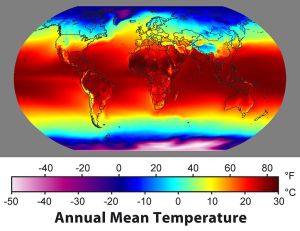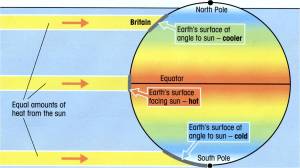Developing hinge questions in geography
Over the last few months I’ve been experimenting with the use of hinge questions in geography. So far I have found they have acted as an exceptionally useful and quick diagnostic tool which identifies student misconceptions so I can make timely interventions before we move onto another task or phase within our learning sequence.
I thought it might be helpful if I shared some of the hinge questions I have been deploying and, to provide some context, what the learning intentions were behind each question.
Context – Year 8 – Why is Svalbard so cold?
Learning intention – Why does air temperature vary across the world?
In this phase of lessons on Fantastic Places, inspired by Noel Jenkins, students carry out an investigation into the physical and human characteristics that make Svalbard a unique and fantastic place. Our phase of lessons starts with a quick detour into interpreting climate graphs and also addressing why air temperature varies across the world.
Some of the geographical data we ask students to examine includes,
Atlases to locate Leicester and Svalbard,
Climate graphs of each location, Svalbard + Leicester
Diagrams of global air temperature difference across a year,
This diagram from an Interactions textbook,
Students complete a range of learning activities in relation to these resources and are guided to extract some meaning from the data. Before we reflect on what has been learned and its wider significance, the deployment of a hinge question at this point in the learning is a useful diagnostic tool.
Essentially, at this point I need to know if students can appreciate that the shape of the Earth, the fact that it is a sphere, helps explain why it is that places by the Equator are warmer than places near the Poles. In my experience, while Y8 students usually know that locations near the Equator are warm and Polar regions are colder, they are often not able to, or have many misconceptions about why this is the case. Hence the learning intention behind the key enquiry question for this lesson.
The Hinge Question…
I ask students to use their mini whiteboard to respond to the following question.
The main reason air temperature varies across the globe is because…
A- The Earth orbits the sun
B- The Earth orbits the sun at an angle
C- The Earth is a sphere
D – The Earth has a hot core
This question was developed because the distracters A, B and D have all been offered as explanations as to why air temperature varies across the world in the past by students. As a result, the distracters in this question really require all students to think carefully about which response is the most appropriate answer to the question posed. If I get a class of C responses I can be reasonably confident that the students can appreciate that the shape of the Earth has a significant impact on differences in air temperature across the globe.
In the reflection stage, to develop student thinking, we discuss some of the air temperature anomalies which exist on the air temperature map and briefly explore what the reasons for these might be. Although this provides an additional degree of challenge in their thinking, we don’t get too caught up in these anomalies at this point as the units of work we complete in Y9 offer opportunities to extend their understanding to explore the interactions between global climate, the atmosphere, ice and oceans.
I’ll post up a few more hinge questions we have used over the next week.



